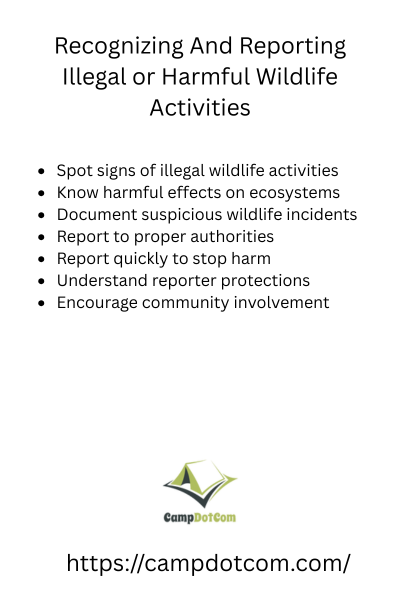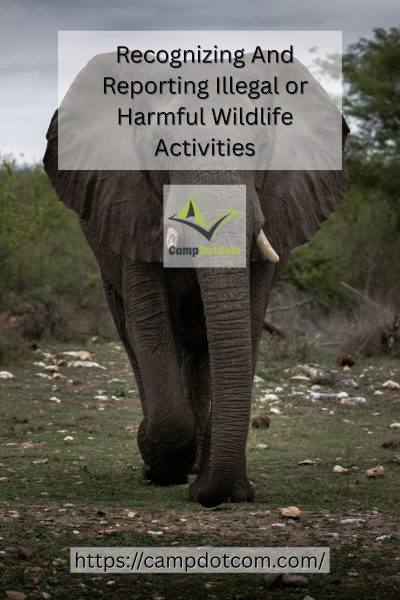If you have ever spent time outdoors, you probably get why recognizing and reporting illegal or harmful wildlife activities matters so much. I mean, there is something magical about spotting a wild animal in its natural habitat, but there is also a dark side when people harm or exploit wildlife. That is where you and I can make a difference.
Read More About Recognizing and Reporting Illegal or Harmful Wildlife Activities

Why Should You Care About Illegal Wildlife Activities?
I remember one afternoon hiking in a local forest when I stumbled across a strange trap hidden under some leaves. At first I thought it was just some leftover camping gear, but then I saw a small injured animal nearby. It hit me that someone was trapping wildlife illegally and that poor creature was suffering because of it. That moment made me realize that spotting and reporting these activities is not just for experts; it is something anyone can do.
Illegal wildlife activities can mean a lot of things like poaching, trapping, selling protected species, or damaging habitats. These actions do not just hurt animals, they mess up entire ecosystems which eventually impacts us too. Crazy right? How something that happens in the forest can come back to bite us in the city.
As an Amazon Associate, I earn from qualifying purchases. Some of the links in this article are affiliate links. This means that, at zero cost to you, I will earn an affiliate commission if you click through the link and finalize a purchase.
More Things to Know About Recognizing and Reporting Illegal or Harmful Wildlife Activities

How to Recognize Illegal or Harmful Wildlife Activities
So, how do you know when something fishy is going on? Here are some signs that can help you spot illegal or harmful wildlife activities:
– You might see traps, snares, or cages placed in the wild where they shouldn’t be.
– Notice animals being kept in poor conditions, like cramped cages or strange containers.
– Hear gunshots or loud noises in protected areas.
– Spot people collecting or selling animals or animal parts where it’s not allowed.
– See signs of habitat destruction like cutting down trees or clearing brush in restricted zones.
These might sound obvious, but when you’re out enjoying nature, sometimes it’s easy to miss the small details. That’s why keeping your eyes peeled matters.
What to Do When You Spot Something Suspicious
Now, spotting illegal activity is the first step — but reporting it is the real game-changer. It can feel a little intimidating, right? Like, who do you call? What if it’s a false alarm? I get it. But here’s the good news: you don’t have to be a wildlife expert or a cop to help.
First, make sure you’re safe. Don’t confront anyone or put yourself in harm’s way. Take notes or photos if you can (safely!), because those details help authorities take action. Then, contact the right people. This could be local wildlife agencies, park rangers, or even a wildlife crime hotline. Many places have anonymous reporting options, so you don’t have to worry about getting involved directly.
I once reported a case where I saw someone selling protected bird species near a nature reserve. I didn’t know the exact rules or laws, but I called the local wildlife office, shared what I saw, and guess what? They handled it. The person was warned, and the birds were taken to a safe place. It felt good knowing that little effort from me made a difference.
Why Reporting Makes a Difference
You might wonder, does reporting really help? It does, more than you think. Illegal wildlife activities often go unnoticed because there are not enough eyes watching. When more people report, it puts pressure on authorities to take action. Plus, it discourages offenders who realize the community is paying attention.
Reporting also helps protect biodiversity. Every animal and plant plays a role in the environment, and losing even one species can upset the balance. On top of that, some illegal wildlife activities can spread diseases that affect people. So keeping wildlife safe means keeping ourselves safe too.
How You Can Stay Informed and Ready
Want to be better prepared to recognize and report illegal or harmful wildlife activities? Here are some simple ways to stay in the loop:
– Follow local wildlife agencies and conservation groups on social media. They often share alerts or tips.
– Join community nature groups or forums where people talk about wildlife and report issues.
– Educate yourself about the species and habitats around your area. The more you know, the easier it is to spot something off.
– If you’re out hiking or camping, keep your phone charged and ready for photos or emergency calls.
Trust me, staying informed makes you feel more confident, and you might even inspire others to keep an eye out too.
Recognizing And Reporting Illegal or Harmful Wildlife Activities: Your Role Counts
At the end of the day, protecting wildlife isn’t just the job of government or scientists — it’s something you and I can do every time we head outdoors or see something suspicious. Recognizing and reporting illegal or harmful wildlife activities is about being part of a community that cares.
Next time you’re out on a trail or visiting a park, remember that you have the power to help protect the amazing creatures we share the planet with. And if you ever feel unsure about what you’ve seen, don’t hesitate to reach out to local authorities. It might just be the difference between an animal living free or suffering in silence.
So, are you ready to be a wildlife watchdog? I promise it’s easier than you think, and it feels pretty great knowing you’re doing your bit for nature.
Thanks for sticking with me! If you want, I can share some tips on how to report effectively or where to find local contacts next time. Just let me know!
